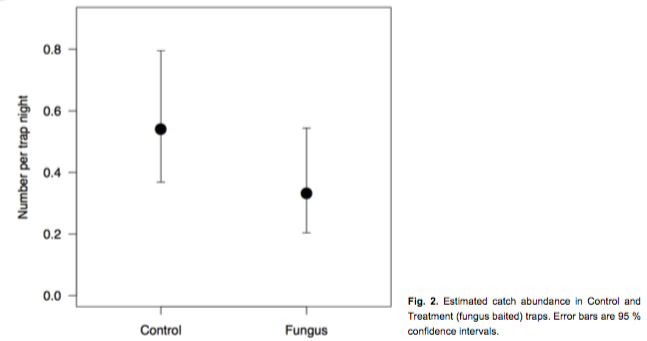Bioluminescence in the ghost fungus Omphalotus nidiformis does not attract potential spore dispersing insects
Omphalotus nidiformis (Agaricales, Marasmiaceae), commonly called the ghost fungus, is a bioluminescent fungus with a widespread distribution in temperate zones of Australia.

Omphalotus nidiformis (Agaricales, Marasmiaceae), commonly called the ghost fungus, is a bioluminescent fungus with a widespread distribution in temperate zones of Australia. A study conducted by researchers at The University of Adelaide, suggests that bioluminescence in O. nidiformis does not attract potential spore dispersing insects, as has been demonstrated in other bioluminescent fungi. Weinstein, et al. reached this conclusion by examining three aspects: circadian rhythmicity of bioluminescence; field-recorded insect abundance at the time of basidiome production; and attractiveness of glowing fungi to flying insects.
They found that basidiomes glowed continuously day and night, and were present in winter (June-July) when insect abundance was low. The abundance of potential spore-dispersing insects was very low, as would be expected in mid-winter. Regarding attractiveness, they used sticky-traps in open woodland in the absence of light pollution, baited with fresh bioluminescent O. nidiformis and control sticky traps, for 480 trap-hours on moonless nights. There was no statistical difference in mean insect abundance between treatment and control traps (mean 0.33 and 0.54 individuals per trap night, respectively). Weinstein, et al. hypothesized that for some fungi, bioluminescence may be an incidental by-product of metabolism rather than conferring any selective advantage and that it is possible that the role of bioluminescence differs among evolutionary lineages of fungi and/or with attributes of their growth environments that could affect spore dispersal, such as wind and insect abundance.

Source:
- Weinstein P, Delean S, Wood T, Austin AD (2016) Bioluminescence in the ghost fungus Omphalotus nidiformis does not attract potential spore dispersing insects. 7: 229–234



 Print
Print Email
Email



